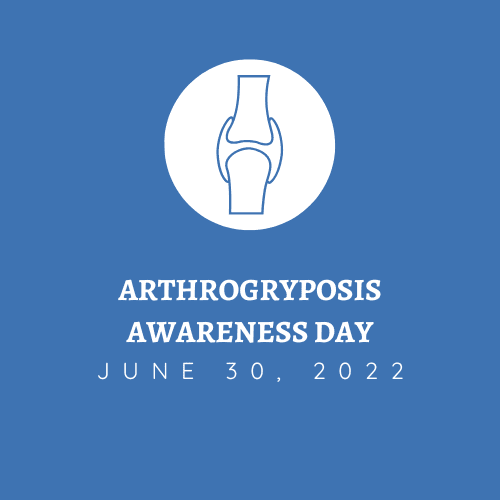Every year, June 30 is marked as Arthrogryposis Awareness Day. It was created by Ani Samargian, the founder of Arthrogryposis Multiplex Congenita Support Inc., back in 2005. The day is dedicated to spreading awareness about arthrogryposis multicomplex congenita (AMC), a rare disease that consists of multiple joint contractures.
Arthrogryposis Multiplex Congenita (AMC)
Arthrogryposis multiplex congenita (AMC) refers to the development of multiple joint contractures affecting two or more areas of the body prior to birth. A contracture occurs when a joint becomes permanently fixed in a bent or straightened position, which can impact the function and range of motion of the joint and may lead to muscle atrophy. AMC is not a specific diagnosis, but rather a physical symptom that can be associated with many different medical conditions. Two of the most common forms of AMC are amyoplasia and a group of genetic disorders called the distal arthrogryposes.
Symptoms:
The most common universal symptom of AMC is limited or absent movement around small and large joints (contractures). The muscles of the affected limbs may be underdeveloped (hypoplastic), resulting in a tube-shaped limb with a soft, doughy feeling. Soft tissue webbing may develop over the affected joints. In addition to joint abnormalities, other findings include:
- Abnormally slender and fragile long bones of the arms and legs and cleft palate
- Undescended testicles in males
- Structural or functional abnormalities of the central nervous system
Additional symptoms associated with AMC are related to the underlying disorder that causes the condition in each individual. The specific symptoms and their severity can vary dramatically based upon the underlying cause. Amyoplasia is the most common form of AMC. Amyoplasia is a disorder characterized by multiple contractures of the joints. The shoulders may be internally rotated and drawn inward (adducted), the elbows are usually extended, and the wrists are usually flexed. In most affected individuals, the fingers are flexed and stiff. Affected individuals usually have severe clubfoot. The distal arthrogryposes are a specific subgroup of AMC. This subgroup is characterized by multiple congenital contractures. Common symptoms include contractures of two or more areas of the body, less involvement of the proximal joints (those joints closest to the center of the body), and highly variable expressivity, which means that specific symptoms vary greatly even among individuals with the same disorder and even in the same family. At least 10 different forms of distal arthrogryposis have been identified.
Causes:
There are many causes of AMC, some of which are inherited. Before birth, four possibilities exist that limit joint movements:
- Abnormal development of muscles
- Inadequate room in the uterus for the baby
- A malformed central nervous system and spinal cord
- Tendons, joints, bones, and joint linings which did not mature correctly
The decrease in range of motion is also caused by extra tissue that has formed around the joint, prohibiting movement.
Diagnosis:
A diagnosis of AMC is made based upon the identification of characteristic symptoms, a detailed patient history, and a thorough clinical evaluation. Specific tests to confirm the diagnosis may include a muscle biopsy and electromyography.
Treatments:
The treatment of AMC is directed toward the specific findings that are apparent in each individual. Standard physical therapy, which can improve joint motion and avoid muscle atrophy in the newborn period, is beneficial.
How To Get Involved
If you would like to join the nonprofit Arthrogryposis Multiplex Congenita Support, Inc. in spreading awareness on June 30, there are a few ways you can get involved!
- You can use your social media accounts to educate others about AMC, using hashtags such as #blueforAMC, #AMCawarenessday, #ArthrogryposisAwarenessDay, and #AMCcurves.
- Put on one of your blue shirts, snap a picture of you in it, and post it on social media using #BlueForAMC along with one of the other hashtags!
- Post one of the graphics amcsupport.org has created. These can be found here!
- On Facebook and Twitter, you can change your profile picture to be a shade of blue or change it completely to be one of the graphics. In addition, you can change your cover photo on Facebook to be blue or a graphic as well.
- Encourage your friends, family, and colleagues to support the day by wearing blue! You can also send them links to the amcsupport.org/amc-awareness-day website, or just send them an email explaining the importance of AMC Awareness Day.
There are plenty of easy ways to get involved in spreading the word about arthrogryposis multicomplex congenita on AMC Awareness Day. Any way you can get involved helps, so be sure to get involved today!







